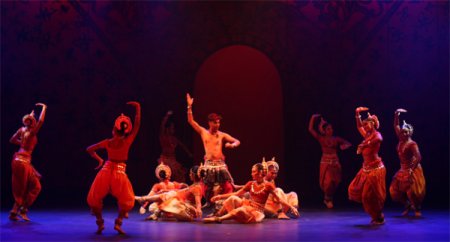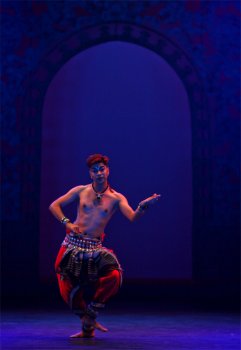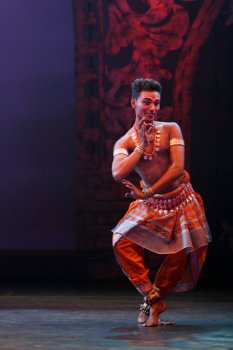
|   |

|   |
A fragrant garland of Pallavis - Dr. Sunil Kothari e-mail: sunilkothari1933@gmail.com Photos courtesy: Sutra September 21, 2012 Watching five pallavis in different ragas, of legendary gurus like Deba Prasad Das, Pankaj Charan Das, Kelucharan Mohapatra and the younger gurus like Durgacharan Ranbir and Gajendra Panda, by disciples of Deba Prasad Das was an exhilarating experience at Panggung Exsperimen Theatre, University of Malaya, on 7th September 2012, as a part of Ramli Ibrahim's Sutra Foundation's Tarikan Dance Festival 2012. Like a jeweler, RamIi has redesigned these pallavis with imagination investing them with newness and arresting beauty. These are rearranged for group composition by Guna and Ramli and they capture the attention of the audiences the moment the very first strain of musical instruments is heard. Sivarajah Natarajan's set design, with back drop of patterned flowers and arches, reminding one of the arch of Rani Gumpha cave sculpture, and exquisite, at times diffused and at times effulgent, lighting of various hues and colours, evoking different moods, and in consonance with music and movements takes one's breath away. There is such wonderful rapport among the choreographers, the dancers and the lights designer, built over many years that the entire production from the word go to the end, mesmerizes the onlookers. The musicians Bhubaneswar Mishra and gurus Deba Prasad Das, Pankaj Charan Das and Kelucharan Mohapatra have given to world of Odissi dance such melodious pallavis, drawing from musical traditions of the native Odishan soil, that for the past fifty years some of us are drunk on its ambrosia like quality. At times one starts feeling that this music dominates our responses with the movements inspired from Odishan sculptures. The configuration of all these elements result in rasanishaptti, relish of that indescribable experience termed as Rasa, the flavor, the taste. It engulfs us, and with progression of each pallavi, drenches us in exhilaration often having what the rhetoricians say romanch, goose pimples. Sutra's pallavis are indeed contemporary interpretations of a classical dance genre in the Odissi repertoire. The treatment is one is tempted to say almost 'inimitable' modern and innovative. The choreographers transform, layer, and nuance them into visuals which are compelling and linger long in memory. In India, dancers and choreographers have also attempted group choreographies of pallavis. But far away from India, in Malaysia, Ramli has sown the seeds of Odissi with such loving care and imagination that they stand out in terms of new concepts and group arrangements. And it is this treatment which astounds audiences, taking Ramli's creations to an international level, welcomed everywhere. Odissi dance has in recent years drawn its devotees from Russia, Peru, Brazil, Bulgaria to name a few countries, which speak volumes for its appeal and appreciation as a dance form.  Pallavi when set to a raga, often has raga swaroopa, dhyana shlokas which describe the beauty of the raga creating an iconic figure. Raga Mukhari …When dancers start appearing on the stage, Guna who plays the male leader enters from under the arch followed by female dancers with flowers and to the Sanskrit description sung in solfa notes in its ascending and descending order, the image is woven and one starts feeling that the 'sympathetic' notes are struck in form of a bevy of beautiful dancers, surrounding the male image of raga and having paid obeisance to the raga, they all celebrate and dance joyously. Having set the mood, to the variations and beats of the tala, the time cycle, the dancers create a series of geometrical formations in a seamless manner. Watching those formations I was reminded of the 'Pindi bandhas' group formations mentioned in the Natya Sastra. It mentions Lata, creeper, Shrinkhla, chain, Bhedyaka, centrifugal and Bandha, centripetal group formations. Watching Manipuri Rasalilas performed by the Jhaveri Sisters when Guru Bipin Singh choreographed those sequences, I had started noticing these Natya Sastra elements. They are arranged with such eye catching movements that one marvels at the choreographer's approach. Visually, they delight us and dancers seem to enjoy creating these patterns. Pallavis in terms of solo presentations are performed by a solo dancer. When Odissi was coming into its own, developing in the hands of these gurus, creation of new pallavis in those years in Arabhi and Sankarabharanam ragas were the rage of the time. Earlier, with Balakrushna Das, Basant pallavi had cast a spell, followed by Kalyan pallavi. Drawing from melodious tune of Dekhi mu para asa re Prana sangini Bansidhar bes ku... and transformed into Kalyan pallavi, one fell under the spell of the genius of these gurus. New delights were added to one's enjoyment musically and visually. The pallavis charmed one and all. Therefore, when I learnt that a garland of pallavis would be presented in one evening, I was curious and ready for the relish. And I must admit that the joy multiplied from one to the next and to the next and so on. Though one had listened to the enchanting notes of Sankarabharanam pallavi of Pankaj Charan Das many years ago and had seen it also in a group presentation, when Sutra dancers danced it one was transported to that nostalgic land of Maya and watched with amazement transformation of it from Pankaj Charan Das's choreography with innovation, dancers appearing with their backs to audience, tribhanga, moving to chauka, to bhramaris, pirouettes, not only by one dancer but several moving on the spot and then in a large circle. At times a male figure is in centre and around him two circles are formed, one inner circle moving in clockwise and outer bigger circle in anti-clockwise direction. The space on the stage gets charged with dancers covering it in broad sweeps and creating undulating patterns with arms extended in an up and down movement , travelling from one dancer to another. Ta jhenu, ta rita jhenu solfa syllables start swaying my frame and my palms involuntarily move in rhythm. Before the next pallavi in Rageshri choreographed by Durgacharan Ranbir begins, lights are dimmed and silhouette figures under the arch enter, lie down on floor imperceptibly and others move in front and are bathed in yellow light. From leisurely chauka, square position, they move further and are multiplied with decoration and when they form a frontal line, one notices swinging movement, their arms move to the solfa notes sa re ga re sa and so on. The kaleidoscopic movements, as if it were a conjurer, gives a little tilt to the instrument and the sight of vision is full of varying patterns. Such magic is woven by the dancers who become a group, none drawing attention to their individual physical form or even visage. The totality of group becomes operative and creates interesting visuals. 

That each guru had his own signature on his creation came into sharp focus when Kelucharan Mohapatra's Arabhi pallavi was staged. Charmed as I am for more than forty years on these evergreen pallavis set to ragas Sankarabharanam and Arabhi of Bhubaneswar Mishra and Kelubabu, growing up watching them being performed by Sanjukta and rendered in mellifluous voice by Raghunath Panighrahi, I was thrilled to watch the group presentation by Ramli incorporating beauteous postures of nayikas, sitting on the floor in graceful poses with one arm planted on the floor and another with palm near the chin, as if admiring the divine form. The leisurely pace in which Arabhi pallavi unfolded with dancers moving slowly in chauka, chauka bhramari, taking arms upwards, holding fingers in abhimana hasta, like teermanam, arms moving in front, the Kelubabu bani revealed itself in full glory. The movements of the vaksha, torso, restrained hip position, strong chauka, moving to fluid tribhanga, et al were performed in sync with effortless ease. The expansion of arms while bending, one group in one direction, other in opposite direction, creating symmetry, like seen in pata painting, highlighted Kelubabu's pictorial inspiration. The filigree work done by Ramli enhanced its appeal whereas the music resonated pleasant memories .The finale in fast tempo received enthusiastic response and the group of dancers dissolved with great flourish. The final pallavi in Bageshri, reminiscent of Yugma Dvandva choreographic piece of Sanjukta and Raghunath Panigrahi, choreographed by Gajendra Panda, disciple of Debaprasad Das, and rearranged by Guna and other dancers, was of course the piece de resistance. The volume and mass elements of group came to the fore in its multiplicity of formations. Dissolving, coming together, repartee, like solfa notes recited to which dancers responded, the male dancers taking leaps and playing drums, to which female dancers responded, accepting challenges and dancing together, was delightful. There were sequences where Guna stood in front and others formed a chain and the group of dancers made an excellent formation as if being driven in a chariot. The increasing number of dancers entering from each wing and forming small circular groups, crossing each other, in opposite directions, created a feeling of lot of activity, none colliding and performing absorbed in one's self, looked fascinating. The final sequence was imaginative when like waves, dancers moved in a mass with movements rising and bending and marching forward which brought down the house. Behind the arch, Guna rose on two male dancers on their knees like one often watches in a Khon masked dance of Thailand, evoking the upright stand of a charioteer seen across the vast expanse of the sky! Such transformations with extremely well trained dancers in group compositions indeed bestowed upon the formation freshness and modern innovative look, enhancing traditional foundation, in all its glory of hauntingly melodious music. Kalidasa, the great Sanskrit poet has said: 'Kshane kshane yam navatam upet, tadeva rupa ramaniyataha' - which invest newness with every moment, that itself is form of beauty. Beauty has never been defined so well. Ramli and the dancers succeed in creating beauty through movements, extending the boundaries of Odissi dance.  Dr. Sunil Kothari is a dance historian, scholar, author and a renowned dance critic. He is Vice President of World Dance Alliance Asia Pacific India chapter, based in New Delhi. He is honored by the President of India with Padma Shri, Sangeet Natak Akademi award and Senior Critic Award from Dance Critics Association, NYC. He is a regular contributor to www.narthaki.com, the roving critic for monthly magazine Sruti and is a contributing editor of Nartanam for the past 11 years. Post your comments Pl provide your name and email id along with your comment. All appropriate comments posted with name and email id in the blog will also be featured in the site. |